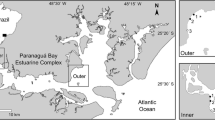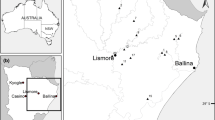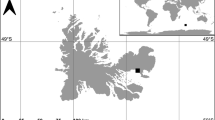Abstract
Plant invasions of coastal wetlands are rapidly changing the structure and function of these systems globally. Alteration of litter dynamics represents one of the fundamental impacts of an invasive plant on salt marsh ecosystems. Tamarisk species (Tamarix spp.), which extensively invade terrestrial and riparian habitats, have been demonstrated to enter food webs in these ecosystems. However, the trophic impacts of the relatively new invasion of tamarisk into marine ecosystem have not been assessed. We evaluated the trophic consequences of invasion by tamarisk for detrital food chains in the Tijuana River National Estuarine Research Reserve salt marsh using litter dynamics techniques and stable isotope enrichment experiments. The observations of a short residence time for tamarisk combined with relatively low C:N values indicate that tamarisk is a relatively available and labile food source. With an isotopic (15N) enrichment of tamarisk, we demonstrated that numerous macroinvertebrate taxonomic and trophic groups, both within and on the sediment, utilized 15N derived from labeled tamarisk detritus. Infaunal invertebrate species that took up no or limited 15N from labeled tamarisk (A. californica, enchytraeid oligochaetes, coleoptera larvae) occurred in lower abundance in the tamarisk-invaded environment. In contrast, species that utilized significant 15N from the labeled tamarisk, such as psychodid insects, an exotic amphipod, and an oniscid isopod, either did not change or occurred in higher abundance. Our research supports the hypothesis that invasive species can alter the trophic structure of an environment through addition of detritus and can also potentially impact higher trophic levels by shifting dominance within the invertebrate community to species not widely consumed.






Similar content being viewed by others
References
Able KW, Hagan SM, Brown SA (2003) Mechanisms of marsh habitat alteration due to Phragmites: response of young-of-the-year mummichog (Fundulus heteroclitus) to treatment for Phragmites removal. Estuaries 26:484–494
Ashton IW, Hyatt LA, Howe KM, Gurevitch J, Lerdau MT (2005) Invasive species accelerate decomposition and litter nitrogen loss in a mixed deciduous forest. Ecol Appl 15:1263–1272
Ayres DR, Smith DL, Zaremba K, Klohr S, Strong DR (2003) Spread of exotic cordgrasses and hybrids (Spartina sp.) in the tidal marshes of San Francisco Bay, CA, USA. Biol Invasions 6:221–231
Bailey JK, Schweitzer JA, Whitham TG (2001) Salt cedar negatively affects biodiversity of aquatic macroinvertebrates. Wetlands 21:442–447
Baum BR (1978) The Genus Tamarix. Israel Academy of Sciences and Humanities, Jerusalem
Bickel DJ, Dyte CE (1989) Family Dolichopodidae. In: Evenhuis NL (ed) A catalog of Australasian and Oceanian Diptera. Brill, Leiden, pp 398–418
Blanchard G, Ghretiennot-Dinet MJ, Dinet A, Robert JM (1988) A simplified method for sorting microphytobenthos from sediments using Ludox Silica-sol. C R Acad Sci Biol Mar 307:569–576
Bruno JF, Bertness MD (2001) Habitat modification and facilitation in benthic marine communities. In: Bertness MD, Gaines SD, Hay ME (eds) Marine community ecology. Sinauer Associates, Sunderland, pp 201–221
Carefoot TH (1973) Feeding, food preference, and the uptake of food energy by the supralittoral isopod Ligia pallasii. Mar Biol 18:228–236
Carman KR, Fry B (2002) Small-sample methods for delta C-13 and delta N-15 analysis of the diets of marsh meiofaunal species using natural-abundance and tracer-addition isotope techniques. Mar Ecol Prog Ser 121:99–116
Chambers RM, Osgood DT, Bart DJ, Montalto F (2003) Phragmites australis invasion and expansion in tidal wetlands: interactions among salinity, sulfide, and hydrology. Estuaries 26:396–406
Chapin FS, Walker BH, Hobbs RJ, Hooper DU, Lawton JH, Sala OE, Tilman D (1997) Biotic control over the functioning of ecosystems. Science 277:500–504
Chapman JW, Dorman JA (1975) Diagnosis, systematics, and notes on Grandidierella japonica (Amphipoda: Gammaridea) and its introduction to the Pacific Coast of the United States. Bull South Calif Acad Sci 74:104–108
Clarke KR (1993) Non-parametric multivariate analyses of changes in community structure. Aust J Ecol 18:117–143
Clarke KR, Warwick RM (1994) Change in marine communities: an approach to statistical analysis and interpretation. Natural Environment Research Council, Plymouth Marine Laboratory, Plymouth
Crooks JA (2002) Characterizing the consequences of invasions: the role of introduced ecosystem engineers. Oikos 97:153–166
Currin CA, Newell SY, Pearl HW (1995) The role of standing dead Spartina alterniflora and benthic microalgae in salt marsh food webs: considerations based on multiple stable isotope analysis. Mar Ecol Prog Ser 121:99–116
Dash MC, Cragg JB (1972) Selection of microfungi by Enchytraidae (Oilgochaeta) and other members of the soil fauna. Pedobiology 12:282–286
Di Sabatino A, Gerecke R, Martin P (2000) The biology and ecology of lotic water mites (Hydrachnidia). Freshw Biol 44:47–62
Di Tomaso JM (1998) Impact, biology, and ecology of saltcedar (Tamarix spp.) in the southwestern United States. Weed Technol 12:326–336
Ellis LM, Crawford CS, Molles MC (1998) Comparison of litter dynamics in native and exotic riparian vegetation along the Middle Rio Grande of central New Mexico, U.S.A. J Arid Environ 38:283–296
Friedman JM, Auble GT, Shafroth PB, Scott ML, Merigliano MF, Freehling MD, Griffen ER (2005) Dominance of non-native riparian trees in western US. Biol Invasions 7:747–751
Fry B, Sherr EB (1984) δ13C measurements as indicators of carbon flow in marine and freshwater ecosystems. Continental Mar Sci 27:13–47
Fry B, Wainwright SC (1991) Diatom sources of 13C-rich carbon in marine food webs. Mar Ecol Prog Ser 76:149–157
Greenstein DJ, Tiefenthaler LL (1997) Reproduction and population dynamics of a population of Grandidierella japonica (Stephensen) (Crustacea: Amphipoda) in Upper Newport Bay, California. Bull South Calif Acad Sci 96:34–42
Grosholz ED (2002) Ecological and evolutionary consequences of coastal invasions. Trends Ecol Evol 17:22–27
Herman PMJ, Middelburg JJ, Widdows J, Lucas CH, Heip CHR (2000) Stable isotopes as trophic tracers: combining field sampling and manipulative labeling of food resources for macrobenthos. Mar Ecol Prog Ser 204:79–92
Herrera AM, Dudley TL (2003) Reduction of riparian arthropod abundance and diversity as a consequence of giant reed (Arundo donax) invasion. Biol Invasions 5:167–177
Kennedy TA, Finlay JC, Hobbie SE (2005) Eradication of invasive Tamarix ramosissima along a desert stream increases native fish density. Ecol Appl 15:2072–2083
Kennedy TA, Hobbie SE (2004) Saltcedar (Tamarix ramosissima) invasion alters organic matter dynamics in a desert stream. Freshw Biol 49:65–76
Kwak TJ, Zedler JB (1997) Food web analysis of southern California coastal wetlands using multiple stable isotopes. Oecologia 110:262–277
Levin LA, Talley TS, Hewitt J (1998) Macrobenthos of Spartina foliosa (Pacific cordgrass) salt marshes in Southern California: community structure and comparison to a Pacific mudflat and a Spartina alterniflora (Atlantic smooth cordgrass) marsh. Estuaries 21:129–144
Levin LA, Talley TS (2000) Influences of vegetation and abiotic environmental factors on salt marsh benthos. In: Weinstein MP, Kreeger DA (eds) Concepts and controversies in tidal marsh ecology. Kluwer, Amsterdam, pp 661–708
Levin LA, Currin CA (2005) Recovery of trophic function in restored Pacific wetlands. CA Sea Grant College program. Research completion report (UCSD). Paper Coastal 04–04
Levin LA, Neira C, Grosholz ED (2006) Invasive cordgrass modifies wetland trophic function. Ecology 87:419–432
McCutchan JH, Lewis WM, Kendall C, McGrath CC (2003) Variation in trophic shift for stable isotope ratios of carbon, nitrogen and sulfur. Oikos 102:378–390
Moore JC, Berlow E, Coleman D, de Ruiter C, Dong Q, Hastings A, Collins Johnson N, McCann K, Melville K, Morin P, Nadelhoffer K, Rosemond A, Post D, Sabo J, Scow K, Vanni M, Wall D (2004) Detritus, trophic dynamics and biodiversity. Ecol Lett 7:584–600
Morisette JT, Jarnevich CS, Ullah A, Cai W, Pedelty JA, Gentle JE, Stohlgren TJ, Schnase JL (2006) A tamarisk habitat suitability map for the continental US. Front Ecol Envi 4:11–17
Moseman S, Levin LA, Currin C, Forder C (2004) Infaunal colonization, succession, & nutrition in a newly restored wetland at Tijuana Estuary, CA. Est Coast Shelf Sci 60:755–770
Neira C, Levin LA, Grosholz ED (2005) Benthic macrofaunal communities of three sites in San Francisco Bay invaded by hybrid Spartina, with comparison to uninvaded habitats. Mar Ecol Prog Ser 292:111–126
Neira C, Grosholz ED, Levin LA, Blake R (2006) Mechanisms generating modification of benthos following tidal flat invasion by a Spartina hybrid. Ecol Appl 16:1391–1404
Neira C, Levin LA, Grosholz ED, Mendoza G (2007) Influence of invasive Spartina growth stages on associated macrofaunal communities. Biol Invasions 9:975–993
Olson JS (1963) Energy storage and the balance of producers and decomposers in ecological systems. Ecology 44:322–331
Osgood DT, Yozzo DJ, Chambers RM, Jacabson D, Hoffman T, Wnek J (2003) Tidal hydrology and habitat utilization by resident nekton in Phragmites and non-Phragmites marshes. Estuaries 26:522–533
Pennings SC, Carefoot TH, Siska EL, Chase ME, Page TA (1998) Feeding preferences of a generalist salt marsh crab: relative importance of multiple plant traits. Ecology 79:1968–1979
Petersen BJ, Howarth RW, Garritt RH (1985) Multiple stable isotopes used to trace the flow of organic matter in estuarine food webs. Science 227:1361–1363
Posey MH (1988) Community changes associated with the spread of an introduced seagrass, Zostera japonica. Ecology 69:974–983
Rooth JE, Stevenson JC, Cornwell JC (2003) Increased sediment accretion following invasion by Phragmites australis: the role of litter. Estuaries 26:476–483
Schlein Y, Muller G (1995) Assessment of plant tissue feeding by sand flies (Diptera: Psychodidae) and mosquitoes (Diptera: Culicidae). J Med Entomol 32:882–887
Stein BA, Flack SR (eds) (1996) America’s least wanted: alien species invasions of U.S. ecosystems. The Nature Conservancy, Arlington, Virginia
Sterner RW, Elser JJ (2002) Ecological stoichiometry: the biology of elements from molecules to the biosphere. Princeton University Press, Princeton
Stevens LE (2000) A synthesis on the ecology and management of saltcedar (Tamaricaceae: Tamarix ramosissima), with emphasis on the Grand Canyon region: final progress report. Grand Canyon Wildlands Council, Flagstaff
Talley TS, Levin LA (1999) Macrofaunal succession and community structure in Salicornia marshes of southern California. Est Coast Shelf Sci 49:713–731
Talley TS, Levin LA (2001) Modification of sediments and macrofauna by an invasive marsh plant. Biol Invasions 3:51–68
Twilley RR, Pozo M, Garcia VH, Rivera-Monroy VH, Zambrano R, Bodero A (1997) Litter dynamics in riverine mangrove forests in the Guayas River estuary, Ecuador. Oecologia 111:109–122
van Oevelen D, Moodley L, Soetaert K, Middelburg JJ (2006) The trophic significance of bacterial carbon in a marine intertidal sediment: results of an in situ stable isotope labeling study. Limnol Oceanog 51:2349–2359
Vitousek PM, D’Antonio CM, Loope LL, Westbrooks R (1996) Biological invasions as global environmental change. Am Sci 84:468–478
Wardle DA, Bardgett RD, Klironomos JN, Setala H, van der Putten WH, Wall DH (2004) Ecological linkages between aboveground and belowground biota. Science 304:629–663
Wavre M, Brinkhurst BO (1971) Interactions between some tubificid oligochaetes and bacteria found in the sediments of Toronto Harbor. J Fish Res Board Can 28:335–341
Webster JR, Benfield EF (1986) Vascular plant breakdown in freshwater ecosystems. Annu Rev Ecol Syst 17:567–594
West JM, Williams GD, Madon SP, Zedler JB (2003) Integrating spatial and temporal variability into analysis of fish food web linkages in Tijuana Estuary. Environ Biol Fish 67:297–309
Whitcraft CR (2007) Wetland plant influence on sediment ecosystem structure and trophic function. Diss. Scripps Institution of Oceanography, UCSD, 2007
Whitcraft CR, Levin LA (2007) Regulation of benthic algal and animal communities by salt marsh plants: impact of shading. Ecology 88:904–917
Whitcraft CR, Talley DM, Crooks JA, Boland J, Gaskin J (2007) Invasion of tamarisk (Tamarix spp.) in a southern California salt marsh. Biol Invasions 9:875–879
White DS, Howes BL (1994) Nitrogen incorporation into decomposing tissue litter of Spartina alterniflora. Limnol Oceanogr 39:629–633
Williams GD, West JM, Zedler JB (2001) Shifts in fish and invertebrate assemblages of two southern California estuaries during the 1997–98 El Nino. Bull South Calif Acad Sci 100:212–226
Zajac RN, Whitlatch RB (1982) Response of estuarine infauna to disturbance II. Spatial and temporal variation of succession. Mar Ecol Prog Ser 10:15–27
Zavaleta E (2000) Valuing ecosystem services lost to Tamarix invasion. In: Mooney HA, Hobbs RJ (eds) Invasive species in a changing world. Island Press, Washington, D.C, pp 261–299
Zedler JB, Nordby CS, Kus BE (1992) The ecology of Tijuana Estuary. NOAA Office of Coastal Resource Management, Washington D.C
Acknowledgments
We thank the staff of Tijuana River National Estuarine Research Reserve (NERR), field assistants and laboratory helpers, especially P. McMillan, G. Mendoza, J. Gonzalez, J. Fodrie, J. Leddick, L. Pierotti, J. Hart, L. Warner-Lara, E. Kim, K. McFarland, M. Cordrey, M. Kiener, and C. Cody. D. Harris and the UC Davis Stable Isotope Facility provided prompt and accurate isotope analyses. Thanks also to C. Neira, T. Talley, and anonymous reviewers for helpful comments on the manuscript. This research was supported by the National Sea Grant College Program of the U.S. Department of Commerce’s NOAA Grants R/CZ 173 and R/CZ 190C through the CA Sea Grant and by the CA State Resources Agency, by the Edna Bailey Sussman fund, by CEQI Grant to LAL 06-000531-02, by the National Science Foundation under Grant OCE 0333444, by 2006 Space Grant (CalSpace), by a San Diego Foundation Blasker Grant, and by the Western Regional Panel of the Aquatic Nuisance Species Task Force. The views expressed herein do not necessarily reflect the views of those organizations. Access to the study site was granted by the NOAA NERR and US Fish and Wildlife Service.
Author information
Authors and Affiliations
Corresponding author
Additional information
Communicated by Barbara Downes.
Electronic supplementary material
Below is the link to the electronic supplementary material.
Rights and permissions
About this article
Cite this article
Whitcraft, C.R., Levin, L.A., Talley, D. et al. Utilization of invasive tamarisk by salt marsh consumers. Oecologia 158, 259–272 (2008). https://doi.org/10.1007/s00442-008-1144-5
Received:
Accepted:
Published:
Issue Date:
DOI: https://doi.org/10.1007/s00442-008-1144-5




